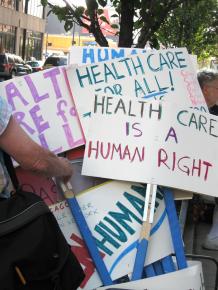How about a healthy stimulus?
reports on a study that bolsters the case for a national single-payer health care system.
A NEW study by the Institute for Health & Socio-Economic Policy (IHSP) debunks the myth that a national single-payer health care system would be too expensive to implement and a drag on the economy.
On the contrary, say the authors of "Single Payer/Medicare for All: An Economic Stimulus Plan for the Nation," a single-payer system would be a major economic stimulus during a time of severe recession, like now.
The argument from opponents of single-payer is that a government-financed health care system isn't economically "feasible," and coverage for everyone can't be guaranteed. The IHSP study demolishes these claims.
According to the authors, a single-payer system would create 2.6 million new jobs, provide $100 billion in wages and infuse $317 billion in new business and public revenues into the economy. The number of jobs that would be created by a single-payer system parallels almost exactly the total job loss in 2008.
Don DeMoro, the lead author of the study, said, "Through direct and supplemental expenditures, health care is already a uniquely dominant force in the U.S. economy." Overall, the industry accounts for $2.1 trillion in direct expenditures--and according to the study, every direct health care dollar creates nearly three additional dollars in the U.S. economy.
Currently in the health-care sector:
There are 18 million employees in the health care industry;
Health care generates another 26 million jobs in other industries for a total of 44 million jobs;
Health care is 9.2 percent of the nation's Gross National Product;
Health care accounts for about 25 percent of all federal tax revenues. Federal, state and local taxes from the health care sector in 2006 added up to $824 billion
IT'S EASY to see how the provision of health care has an impact throughout the economy and society. Walk into a hospital or clinic, and everything you see, from the syringe that delivers medicine, to the dialysis machine, to the computer that takes digital pictures of the brain (MRI) had to be manufactured. Thousands of important breakthroughs in medical technology over the last 20 years have made it possible to diagnose and treat diseases that in the past would have resulted in death.
There are millions of health-care workers providing vital services. Registered nurses number more than 2 million, approximately 25 percent of all health care professional employees. Nursing aides, orderlies and home health aides make up a similar percentage. By contrast, medical doctors are only 3 percent of the health care workforce.
The study shows that bringing the 50 million uninsured into the system is the key to increasing both jobs and economic growth. The reason, explains DeMoro, is because "the broadest economic benefits directly accrue from the actual delivery and provision of health care, not the purchase of insurance."
Moving to a single-payer system could be achieved for $63 billion more than the current $2.1 trillion in direct health care spending. The $63 billion is six times less than the federal bailout for Citigroup and half the bailout for insurance giant AIG.
So why isn't the study from the IHSP front-page news and the lead story on every network news show? Why aren't the politicians keen to jolt the economy back to life and guarantee "universal" health care to every American at the same time? And why isn't health care a central plank of President Obama's stimulus package?
The reason: the study proves unequivocally that the private insurance industry and the free market have no role to play in the delivery of health care. Only a single-payer, government-financed system can end the health care crisis.
That's an "inconvenient truth" for Obama, who used to be in favor of single-payer. Instead, he is pushing incremental, stopgap measures that have all been tried before and failed.
Last month, nearly 600,000 people lost their jobs--and many of them lost their health care with their employment. States across the country are facing massive budget deficits and are cutting Medicaid, closing clinics and eliminating services at hospitals to over come them.
The solution to the health care crisis is a bill introduced in the House of Representatives--Rep. John Conyer's H.R. 676, renamed the United States National Health Care Act. The bill would enact a single-payer health care system and abolish the private insurance industry.
But to get this bill passed into law, supporters of single-payer will have to mobilize. There has been no better time to fight for a single-payer system that makes health care a human right that can never be taken away.



